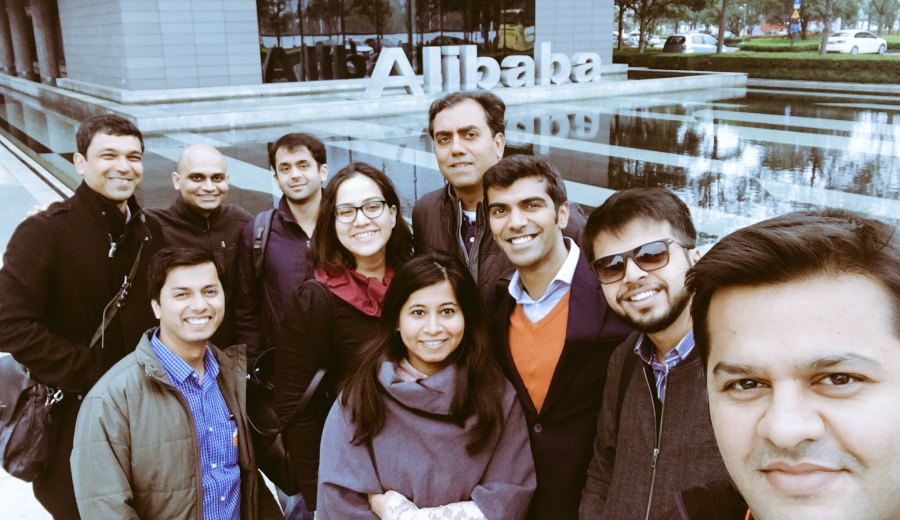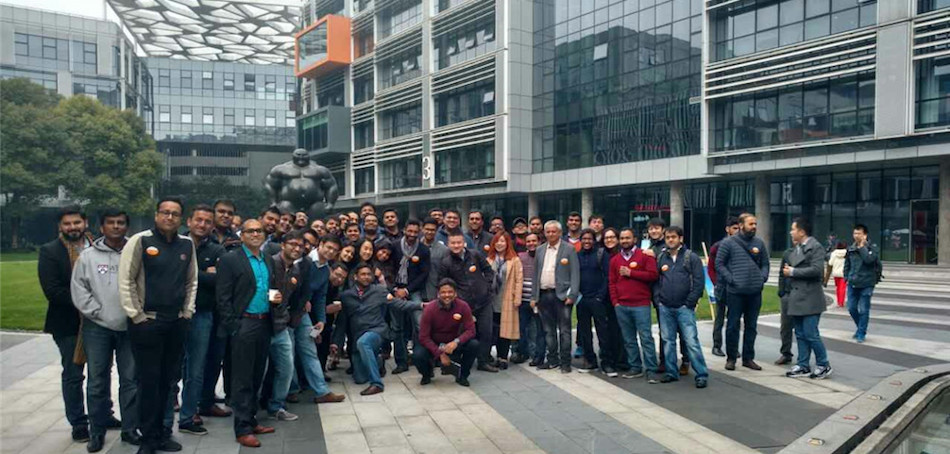
Blume Ventures managing partner Karthik Reddy is at extreme left, while his co-founder Sanjay Nath is the tall one in the middle. Photo credit: Blume.
If you happened to be in Hangzhou on a crisp spring morning in late March, you would have witnessed an unusual spectacle: two busloads of Indian startup founders arriving at Alibaba HQ, posing for group selfies, and taking a guided tour of China’s biggest internet success.
The entourage consisted mainly of startups from the portfolio of Blume Ventures, one of India’s earliest and most active seed-stage funds. They were accompanied by both the co-founders and managing partners of Blume – Karthik Reddy and Sanjay Nath.
Just how unusual this was became apparent in a conversation I had with Karthik in the bus. It was his first visit to China. And he had arrived with the whole Blume gang. So, what’s changed for these Indian investors and founders to make this collective trip now?
If not now, when?

A poster on the grounds at Alibaba HQ in Hangzhou. Photo credit: Tech in Asia.
Karthik and Sanjay founded Blume in 2010 after connecting as fellow Mumbai angels. They had a lot in common: graduating from premier engineering colleges IIT Roorkee and BITS Pilani, going to the US for MBAs at Wharton and UCLA, working for US multi-nationals like American Express and IBM.
They had lived in the US and were now frequent travellers to Silicon Valley – to raise money for Blume which closed its second fund late last year, line up series A rounds for its startups, or find partners for co-investment as they did recently with Draper Venture Network. China wasn’t on the radar.
Chinese companies and investors were so busy making hay in the booming domestic market that they had no time for the large tech ecosystem and market next door either. Their overseas investments were mostly in Silicon Valley. The cash-rich Baidu, Alibaba, Tencent, and JD made 90 deals there worth US$7.7 billion between 2012 and 2016.
It’s only recently, with the domestic market getting saturated and hyper-competitive, that the Chinese have looked over the Himalayas separating the giant neighbors that account for a third of the world’s population.
Alibaba tested the waters by investing in mobile payments and ecommerce company Paytm, while Tencent recently followed up its backing of healthcare startup Practo by leading a US$1.4 billion round for ecommerce player Flipkart.

Chindia connection. Photo credit: Tech in Asia.
Question of trust
The next rung of companies and investors are still sniffing the air, trying to figure out if the market is close enough to a takeoff point, not wanting to miss out on an investment bounty. Capital controls imposed last year – after US$1.2 trillion left China following the yuan’s devaluation – also held them back. Only companies with good reserves of cash abroad could come in. But the controls are easing up with cross-border capital flows getting more balanced and foreign exchange reserves rising.
All in all, the timing seemed good to Karthik, who met a slew of investors, companies, and officials during our 10-day tour of the four major tech hubs in China: Beijing, Shanghai, Hangzhou, and Shenzhen. It was organized by ZDream Ventures, a Beijing-based venture capital firm that has opened an outpost in Gurgaon to help make “Chindia” connections.
“In retrospect, if I had come earlier, nothing would have happened,” Karthik tells me in the bus, on our way to an Indian restaurant which plays old Hindi songs. It was like a pit-stop after we had tried and enjoyed several varieties of authentic Chinese cuisine in different settings – the most memorable being one where the waiters wore ornate dresses and served us in a traditional, ceremonial fashion.
“Even now, the Chinese companies and investors have enough going here,” Karthik says, continuing our conversation. “But the smart ones have realized it’s not the end game. India would be like an expansion of the local market for them.”
The main barrier is trust, due to a lack of connections and unfamiliarity with the market. Despite the potential, there are few proven successes in building a sustainable business in India’s consumer internet space.“On this trip, I gave a Chinese investor [in a Blume portfolio company] an assurance that although my first fund is exhausted, for his comfort level I’ll contribute 100k dollars. He thanked me,” says Karthik.
Different from the US

Indian founders and investors inside Alibaba HQ in Hangzhou. Photo credit: ZDream Ventures.
Going forward, however, Karthik sees scope to engage with the Chinese at a level that would be hard to do in Silicon Valley. “The Valley is not interested in direct investments on a small scale,” he points out. “These guys [in China] think ‘we can go and kill this, the Americans are too far away.’ That realization is coming now.”
According to him, US investors haven’t shown much interest in differentiated business models out of India. “If it doesn’t follow a pattern which they’ve understood from another market, they’re reluctant to fund it.”
The Chinese may understand Asian business models better, given a shared culture, especially in the price-to-value effect on consumers. They can take a different view from Valley investors, benchmarking Indian companies against similar ones in China to gauge their potential.
But sometimes that benchmarking can be misleading too. Although the two neighbors have similar demographics, they are on a different plane economically – China’s economy is five times that of India with four times the GDP per capita. An Indian startup can look like a poor cousin when measured against the cost structure and market potential of a Chinese counterpart.
What impresses Karthik though is the Chinese appetite for “creative disruption,” even if they too are nervous about the speed of change and uncertainty of outcomes. “They take a sector by the horns and disrupt it with big bets.”
Well-known cases are Alipay’s transformation of digital payments and WeChat’s all-in-one ecosystem around social media, with ecommerce, payments, and on-demand services being rolled into it – a model that WhatsApp may soon emulate in India by enabling payments.
New examples keep emerging, like bike-sharing unicorn Ofo disrupting urban mobility. It’s tempting to think India offers similar possibilities – but nobody knows when the tipping point will come.
In the second part of this series tomorrow – a comparison of ecosystems and more learnings from the China tour.
This post Alibaba and the 40 founders from India appeared first on Tech in Asia.
from Tech in Asia https://www.techinasia.com/alibaba-40-founders-india
via IFTTT
No comments:
Post a Comment